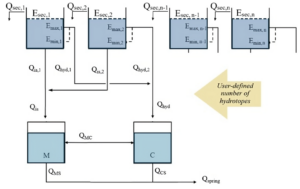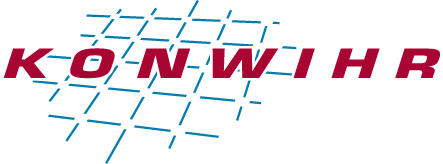Applicant
Prof. Dr. habil. Gabriele Chiogna
Professor for Applied Geology and Modeling of Environmental Systems
Friedrich-Alexander-Universität Erlangen-Nürnberg
Project Summary
The aim of the “Optimization of LuKARS” project was to improve the LuKARS code (Bittner et al., 2018; Richieri et al., 2024) with focus on computational time, flexible implementation of model structures, as well as on sensitivity and parameter optimization methods. LuKARS is a semi- distributed lumped parameter model that was developed to simulate the hydrological impacts of land use changes in a karst system. The model consists of different buckets that represent the dominant hydrotopes in a considered recharge area. The water balance for each bucket is solved using an explicit temporal integration scheme. Each hydrotope is characterized by a different response and contributes to the spring discharge with individual quick flow and infiltration.
The result of the work carried out for the KONWHIR project is a new version of the model, called LuKARS 3.0, which updates the original model written in R, LuKARS 1.0 (Bittner et al., 2018). Compared to the previous version of the code in Python (Richieri et al., 2024), LuKARS 3.0 is characterized by a significant reduction in runtime, achieved through the use of the Numba library in Python, as well as by a flexible implementation that allows the activation of model compartments and fluxes without requiring further modifications to the code. Considering the enormous runtime reduction achieved in the KONWIHR Project, we decided to compare the available results in the literature based on the active subspace method (Teixeira Parente et al., 2019) with more traditional sensitivity analysis and parameter estimation methods applied in the field of hydrogeology (Morris screening (Campolongo et al., 2007; Morris, 1991) and GLUE (Beven and Binley, 1992), respectively). The comparison between the different methods shows consistent results.

References
Beven, K. and Binley, A. (1992). The future of distributed models: Model calibration and uncertainty prediction. Hydrol. Process., 6: 279-298.
Bittner, D., Narany, T. S., Kohl, B., Disse, M., and Chiogna, G. (2018). Modeling the hydrological impact of land use change in a dolomite-dominated karst system. Journal of Hydrology, 567, 267-279.
Campolongo, F., Cariboni, J., and Saltelli, A. (2007). An effective screening design for sensitivity analysis of large models. Environmental Modelling and Software, Modelling, computer-assisted simulations, and mapping of dangerous phenomena for hazard assessment 22, 1509–1518.
Morris, M.D. (1991). Factorial Sampling Plans for Preliminary Computational Experiments. Technometrics 33, 161–174.
Richieri, B., Bittner, D., Sivelle, V., Hartmann, A., Labat, D., and Chiogna, G. (2024). On the value of hydrochemical data for the interpretation of flow and transport processes in the Baget karst system, France. Hydrogeology Journal.
Teixeira Parente, M., Bittner, D., Mattis, S. A., Chiogna, G., and Wohlmuth, B. (2019). Bayesian Calibration and Sensitivity Analysis for a Karst Aquifer Model Using Active Subspaces. Water Resour. Res. 55:7086–7107.

